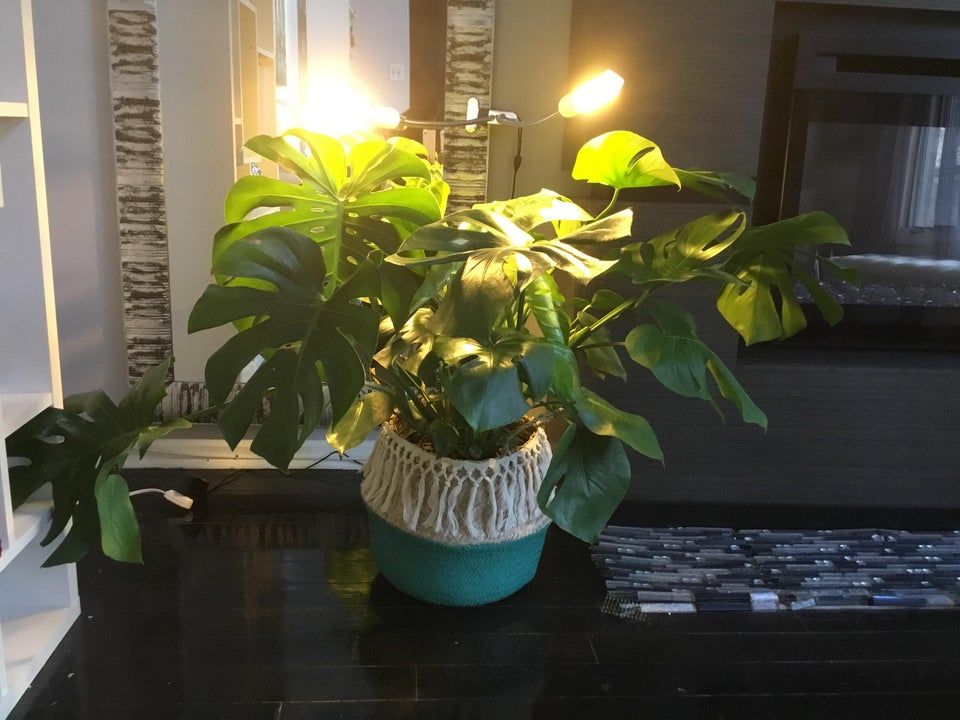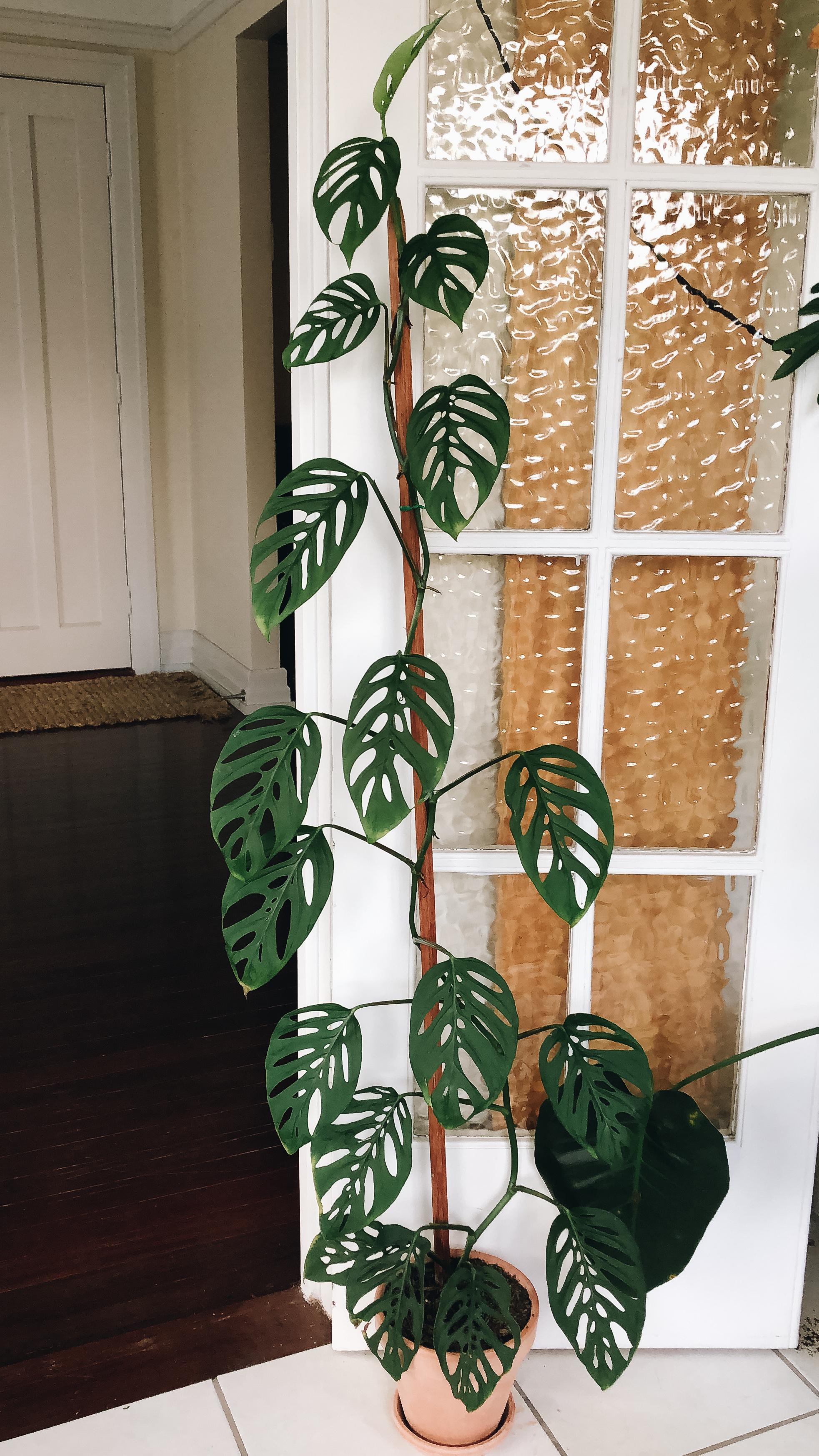Can Monstera Adansonii Live In Low Light?

The Monstera Adansonii plant is a highly resilient hardy plant that can grow in low light. However, they will not grow in ZERO Light and they’re unlikely to thrive if the light conditions aren’t good enough. Although the plant will not die completely, it needs a sufficient supply of light to grow healthily. Light is also needed for the leaves to develop the beautiful fenestrations and variegated leaves that the plant is known for.
You do not need a sunny window to grow most species of the Monstera plant including the Adansonii. They’re perfectly happy with indoor light conditions and most plants will grow sufficiently with the light from your north or south-facing window. They can also be placed on a west-facing window as long as they’re not too close to direct sunlight. Read on to discover all you need to know about the optimal light conditions for your Monstera Adansonii plant.
How Much Light Does A Monstera Need?
You only need medium-to-bright indirect light to keep the Monstera Adansonii in relatively good condition. Also known as the Swiss cheese plant (due to its heart-shaped leaves with holes in them), the Monstera Adansonii plant’s natural origin is the rainforests of South America and Mexico. In its natural habitat, the plant grows in the hot and humid rainforest canopy. As far as light conditions go, canopy plants only receive indirect sunlight that penetrates through to the forest floor. This light condition makes it relatively easy to grow the Swiss cheese plant indoors as a houseplant.
For plants, light is often measured in two ways:
- The duration of the light
- The intensity of the light.
The light duration refers to the amount of time that your plant receives light each day. Light intensity on the other hand refers to how bright the light it receives is. In terms of intensity, light can be described as low, medium, or bright. Terms like indirect light, direct bright light, bright indirect light, or direct sunlight may also be used to describe the light intensity. Both of these conditions are necessary to determine how much light your Monstera Adansonii plant should get.
What Type Of Light Does A Monstera Plant Need?
Generally, your Monstera Adansonii will grow best in bright light but does not tolerate direct sunlight. The plant will survive in low light. However, if the light is too low, the growth is likely to be inhibited. You will need a sufficient supply of light to grow a striking Monstera plant with lacy leaves and the right coloration.
In their natural habitat, the Monstera plants grow bigger leaves based on the amount of light they get. The holes and splits in the leaves are also believed to be an adaptation to allow light to filter through to the leaves below. Hence, if the plant does not get sufficient light, the holey leaves won’t develop properly. The more light your plant gets, the bigger and faster it will grow.

Can I use grow lights for my Monstera Adansonii plant?
Grow lights are becoming increasingly popular as people look for ways to grow plants indoors. There are a number of different types of grow lights available, and each has its own advantages and disadvantages. One of the most popular types of grow lights is LED grow lights. LED grow lights are energy-efficient and produce very little heat, making them ideal for indoor use.
If you're using grow lights to help your monstera plants thrive, you need to be careful not to overdo it. Too much artificial light can cause the leaves to develop brown edges. This is because the plant is trying to adjust to the different light spectrum coming from the grow light. It's important to give your plant a break from the grow light every once in awhile, so it can adjust back to natural light. Otherwise, you might end up with a plant that's not as healthy as it could be. So if you're using grow lights, make sure to use them sparingly and give your monstera plants a chance to rest.
How Many Hours Of Light Does A Monstera Need?
Usually, your Monstera Adansonii plant should get between 5 to 8 hours of bright indirect light per day. However, variegated varieties of this plant such as the Variegatta Monstera deliciosa and the Thai Constellation Monstera deliciosa require more light. These species are typically lacking in chlorophyll which makes it difficult for them to convert the sun’s energy into a usable form. Although the plant will not die, they’re likely to lose its striking white and cream colors if they do not get sufficient sunlight.
In summary, how much light your Monstera plants require depends on the specific variety you’re growing as well as the quality (intensity) of the light. An hour or two of bright sunlight will do your plant a lot of good compared to several hours of weak light.
How Do The Seasons Affect The Quality Of Light?
Another common factor to consider in determining how much light your plant would be getting is the season of the year. Generally, the sun is higher in the sky during the summer and spring months, meaning the light is more intense. Conversely, the sun stays low in the sky during the winter months and the rays are less intense. In some regions, your plants are likely to struggle to get the sufficient amount of light they need to survive in the winter months and you should consider relocating them to a location with more light.

Can Monstera Adansonii Grow In Outdoor Light?
Yes, if acclimatized properly, you may be able to grow your Monstera Adansonii in outdoor light. However, you will have to replicate conditions similar to the jungle floor on which they grow. This means shielding them from bright direct sunlight to keep the plants from suffering a sunburn.
How To Help A Monstera Living In Low Light
To be clear, your Monstera Adansonii plant will most likely not thrive in low light conditions. The plant will not die off completely, but the large, beautiful fenestrated leaves will most likely not be formed since they’re formed as a response to light conditions.
In most cases, the indoor light condition is sufficient to grow your Monstera plant. However, if your indoor space does not get sufficient light, you can get yourself a set of grow lights to augment the light supply. They only need to be on for about 5 hours per day to make up for the poor light. Note that grow lights are not a total replacement for natural lights. Plants grow better and thrive on a windowsill with sufficient light. However, using grow lights will encourage growth when your plants aren’t getting enough natural lights.

Additional Tips To Help Your Monstera Adansonii Thrive In Low Light
In addition to optimizing the light conditions with an artificial light source, there are additional tips to keep in mind if you’re growing your Monstera plant under low light conditions: Some of these include:
Water appropriately: make sure you keep your plant’s water and humidity at an optimal condition. Generally, plants growing in low light conditions will have less energy. You’ll weaken it even more if you drown it in water.
Monitor humidity: You should avoid misting your plant in this condition. Infections occur and spread faster when the leaves of your plant are always in wet conditions which is usually the case when the sunlight is too low. Keep your eye on the humidity condition of your grow room with a hygrometer. If the humidity level drops below 50%, you should look for ways to increase it.
Be wary of pests and infections: Plants are more likely to be affected by pests when they do not get an optimal supply of sunlight. You should watch your plant regularly to identify signs of an infestation in time. You should also take steps to mitigate pests and diseases such as dusting the plant with neem oil. This can also help optimize light absorption in indoor plants.
Conclusion
Generally, keeping your Monstera Adansonii in low light is not recommended. Although the plant will not die due to its hardy nature, it won’t thrive either. Bright indirect light is the best condition to keep your Swiss Cheese plant. You can use artificial light to augment your regular light if the plant isn’t getting sufficient light.